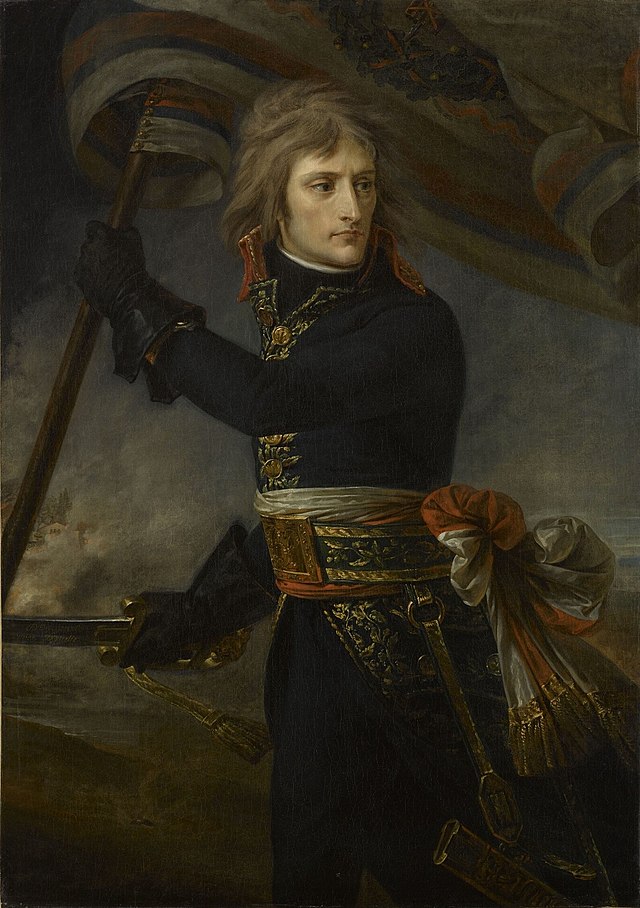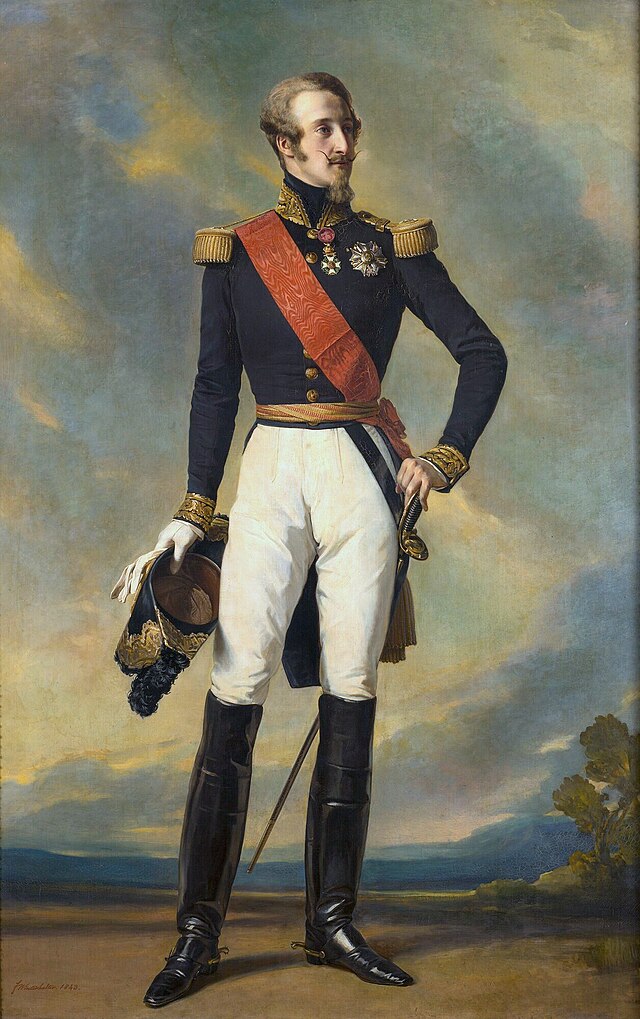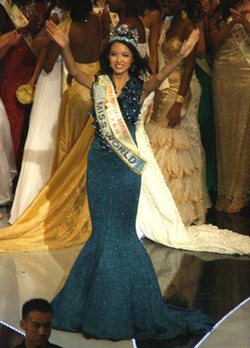Sash
Band of fabric worn on the body From Wikipedia, the free encyclopedia
A sash is a large and usually colorful ribbon or band of material worn around the human body, either draping from one shoulder to the opposing hip and back up, or else encircling the waist. The sash around the waist may be worn in daily attire, but the sash from shoulder to hip is worn on ceremonial occasions only. Ceremonial sashes are also found in a V-shaped format, draping straight from both shoulders down, intersecting and forming an angle over the chest or abdomen.

Military use
Summarize
Perspective
Old Europe

In the mid-and late-16th century waist and shoulder sashes came up as a mark of (high) military rank or to show personal affection to a political party or nation. During the Thirty Years' War the distinctive sash colour of the House of Habsburg was red while their French opponents wore white or blue sashes and the Swedish voted for blue sashes.
Beginning from the end of the 17th century, commissioned officers in the British Army wore waist sashes of crimson silk. The original officer's sash was six inches wide by eighty-eight inches long with a ten-inch (gold or silver) fringe. It was large enough to form a hammock stretcher to carry a wounded officer. From about 1730 to 1768, the officer's sash was worn baudericke wise, i.e. from the right shoulder to the left hip, and afterwards around the waist again.[1]
Sergeants were permitted sashes of crimson wool, with a single stripe of facing colour following the clothing regulations of 1727. Whereas it remained vague whether the sash was to be worn over the shoulder or around the waist, it was clarified in 1747 that sergeants had to wear their sashes around the waist. From 1768, the sergeant's waist sash had one (until 1825) resp. three (until 1845) stripes of facing colour; in regiments with red or purple facings the sergeant's sash had white stripes or remained plain crimson.[2][3]
Until 1914 waist-sashes in distinctive national colours were worn as a peace-time mark of rank by officers of the Imperial German, Austro-Hungarian and Russian armies, amongst others.
The barrel sash is a type of belt traditionally worn by hussars.
Modern Europe
Since then sashes have been part of formal military attire (compare the sword belt known as a baldric, and the cummerbund). Thus several other modern armies retain waist-sashes for wear by officers in ceremonial uniforms. These include the armies of Norway (crimson sashes), Sweden (yellow and blue), Greece (light blue and white), the Netherlands (orange), Portugal (crimson) and Spain (red and gold for generals, light blue for general staff and crimson for infantry officers).[4]
The Spanish Regulares (infantry descended from colonial regiments formerly recruited in Spanish Morocco) retain their historic waist-sashes for all ranks in colours that vary according to the unit.[5]
Sashes are a distinctive feature of some regiments of the modern French Army for parade dress. They are worn around the waist in the old Algerian or Zouave style ("ceinture de laine"). Traditionally these sashes were more than 4 m (13 ft) in length and 40 cm (16 in) in width. In the historic French Army of Africa, sashes were worn around the waist in either blue for European or red for indigenous troops.[6]
(British) Commonwealth of Nations
The modern British Army retains a scarlet sash for wear in certain orders of dress by sergeants and above serving in infantry regiments, over the right shoulder to the left hip. A similar crimson silk net sash is worn around the waist by officers of the Foot Guards in scarlet full dress and officers of line infantry in dark blue "Number 1" dress. The same practice is followed in some Commonwealth armies.
The present-day armies of India and Pakistan both make extensive use of waist-sashes for ceremonial wear. The colours vary widely according to regiment or branch and match those of the turbans where worn. Typically two or more colours are incorporated in the sash, in vertical stripes. One end hangs loose at the side and may have an ornamental fringe. The practice of wearing distinctive regimental sashes or cummerbunds goes back to the late nineteenth century.[7]
Cross-belts resembling sashes are worn by drum majors in the Dutch, British and some Commonwealth armies. These carry scrolls bearing the names of battle honours.
United States of America

In the United States, George Washington, who served as commander-in-chief of the Continental Army during the American Revolutionary War and later served as the first President of the United States, was noted for wearing a blue ribbed sash, similar to that of the British Order of the Garter, early in the war, as he had in 1775 prescribed the use of green, pink, and blue sashes to identify aides de camp, brigade-majors, brigadiers general, majors general, and the commander in chief in the absence of formal uniforms. He later gave up the sash as "unrepublican" and "pretentious for all but the highest-ranking aristocracy", according to historians. Washington is seen wearing the sash in Charles Wilson Peale's 1779 painting Washington at Princeton.[8][9]
Sashes continued to be used in the United States Army for sergeants and officers. In 1821 the red sashes (crimson for officers) were limited to first sergeants and above. In 1872 the sashes were abolished by all ranks but generals continued to wear their buff silk sashes in full dress until 1917. Waist sashes (in combination with a sabre) in the old style are still worn by the officers and senior NCOs of the Commander-in-Chief's Guard of the 3rd U.S. Infantry Regiment (The Old Guard) as well by the West Point Band drum major along with the West Point cadet officers.[10][11] The drum major of the Old Guard Fife and Drum Corps also still wears a waist sash, but no sidearms.
At the time of the American Civil War (1861–65) generals of the regular US Army wore silk sashes in buff. Officers were authorized silk sashes in crimson (medical officers: emerald) while red woollen sashes were entitled to senior non-commissioned officers (Army Regulations of 1861). In the Confederate Army sashes were worn by all sergeant ranks and officers. The colour indicated the corps or status of the wearer. For example: yellow for cavalry, burgundy for infantry, black for chaplains, red for sergeants, green or blue for medics, and grey or cream for general officers.
Myanmar
Since 1948, Burmese presidents have worn the traditional Burmese sash worn by ancient Burmese kings, which resembles a Western-style sash, at state ceremonies. What makes Myanmar sash different from Western countries is that the sash is made of gold, and is called the golden sash.
Japan
Japanese officers continued the practice in full dress uniform until 1940.[12]
Presidential sash

A presidential sash is a cloth sash worn by presidents of many nations in the world. Such sashes are worn by presidents in Africa, Asia, Europe and, most notably, in Latin America.
The sash is an important symbol of the continuity of the presidency and is only worn by the president. Its value as a symbol of the office of the head of state can be compared to that of a crown in monarchies. Presidents leaving office formally present the sash to their successor during the official inauguration ceremony.
Presidential sashes are usually very colorful, large, and designed to resemble the nation's flag, especially those of Latin American presidents. They are usually worn over the right shoulder to the left side of the hip. The national coat of arms is also traditionally placed on the sash. A national order's star or chain of office can also be worn.
Modern civilian and cultural use
Summarize
Perspective



With the genesis of complex systems of military and civilian awards during the 18th century in most European countries, sashes became a distinguishing part of honorific orders and are mostly worn along with decorations and medals. Today, various members of most European royal families wear sashes (also known as ribands) as part of their royal (and/or military) regalia on formal occasions. Some merit orders (such as the French Legion of Honour) also include sashes as part of the senior-most grades' insignia. Likewise, Italian military officers wear light blue sashes over the right shoulder on ceremonial occasions.
In Latin America and some countries of Africa, a special presidential sash indicates a president's authority. In France and Italy, sashes – featuring the national flag tricolours and worn on the right shoulder – are used by public authorities and local officials (such as legislators) during public ceremonial events.
In the United States, the sash has acquired a more ceremonial and less practical purpose. Sashes are used at higher education commencement ceremonies, by high school homecoming parade nominees, in beauty pageants, and by corporations to acknowledge high achievement.
In Canada, hand-woven sashes (known as ceintures fléchées or sometimes "L'Assomption sashes" after a Quebec town named L'Assomption in which they were mass-produced) were derived from Iroquois carrying belts sometime during the 18th century. As a powerful multi-use tool, this sash found use in the fur trade, which brought it into the North West using French voyageurs. During this period, the weave got tighter and size expanded, with some examples more than four metres in length. Coloured thread was widely used. The sash is a shared cultural emblem between French-Canadians and Métis peoples. Today, it is considered to be primarily a symbol of the 1837 Lower Canada Rebellion Patriotes and the Métis Nation. In modern times, Bonhomme Carnaval, the snowman mascot of the Quebec Winter Carnival, wears a ceinture fléchée as part of his attire in recognition of the province's heritage.
In the British Isles, especially Northern Ireland, the sash is a symbol of the Orange Order. Orange Order sashes were originally of the ceremonial shoulder-to-hip variety, as worn by the British military. Over the course of the 20th century, the sash was mostly replaced by V-shaped collarettes, which are still generally referred to as sashes. The item is celebrated in the song "The Sash my Father Wore".
Sashes are also worn by:
- Boy Scouts and Girl Guides, with badges sewn onto the sash to indicate Scouting achievements;
- Beauty pageant contestants, to display their region or title.
Sashes are part of the diplomatic uniform of many countries.
Many modern schools of Chinese martial arts use sashes of various colors to denote rank, as a reflection of the Japanese ranking system using belts. The Japanese equivalent of a sash, obi, serves to hold a kimono or yukata together.
Honorific orders
Summarize
Perspective
Sashes are indicative of holding the class of Grand Cross or Grand Cordon in a chivalric order or an order of merit. The sash is usually worn from the right shoulder to the left hip. A few orders do the contrary, according to their traditional statute.


Orders with the sash worn on the left shoulder
Europe:
 Denmark: Order of the Elephant
Denmark: Order of the Elephant Iceland: Order of the Falcon
Iceland: Order of the Falcon Kingdom of Serbia: Order of the White Eagle
Kingdom of Serbia: Order of the White Eagle United Kingdom: Order of the Garter
United Kingdom: Order of the Garter United Kingdom (Scotland): Order of the Thistle
United Kingdom (Scotland): Order of the Thistle
Asia:
 Myanmar: Order of Thiri Thudhamma
Myanmar: Order of Thiri Thudhamma South Korea: Grand Order of Mugunghwa
South Korea: Grand Order of Mugunghwa Thailand: Order of the Royal House of Chakri[13]
Thailand: Order of the Royal House of Chakri[13] Thailand: Order of Chula Chom Klao[14]
Thailand: Order of Chula Chom Klao[14] Thailand: Knight Grand Cordon (Special Class) on left shoulder but Knight Grand Cross (First Class): right shoulder, for:
Thailand: Knight Grand Cordon (Special Class) on left shoulder but Knight Grand Cross (First Class): right shoulder, for:
| Decorations | Post-nominal | Grade | Ribbon | Sources |
|---|---|---|---|---|
| The Royal Family Order of the Crown of Brunei Darjah Kerabat Mahkota Brunei |
DKMB | Recipient | [17] | |
| The Most Esteemed Family Order of Laila Utama Darjah Kerabat Laila Utama Yang Amat Dihormati |
DK I | Recipient | [17] | |
| The Most Esteemed Family Order of Seri Utama Darjah Kerabat Seri Utama Yang Amat Dihormati |
DK II | Recipient | [17] | |
| The Most Eminent Order of Islam Brunei Darjah Seri Ugama Islam Negara Brunei Yang Amat Bersinar |
PSSUB | First Class | [17] | |
| The Most Illustrious Order of Paduka Laila Jasa Keberanian Gemilang Darjah Paduka Laila Jasa Keberanian Gemilang Yang Amat Cemerlang |
DPKG | First Class | [18] | |
| The Most Exalted Order of Paduka Keberanian Laila Terbilang Darjah Paduka Keberanian Laila Terbilang Yang Amat Gemilang |
DKLT | First Class | [17] | |
| The Most Gallant Order of Pahlawan Negara Brunei Darjah Pahlawan Negara Brunei Yang Amat Perkasa |
PSPNB | First Class | [19] | |
| The Most Blessed Order of Setia Negara Brunei Darjah Setia Negara Brunei Yang Amat Bahagia |
PSNB | First Class | [20] | |
| The Most Distinguished Order of Paduka Seri Laila Jasa Darjah Paduka Seri Laila Jasa Yang Amat Berjasa |
PSLJ | First Class | [21] | |
| The Most Honourable Order of Seri Paduka Mahkota Brunei Darjah Seri Paduka Mahkota Brunei Yang Amat Mulia |
SPMB | First Class | [22] | |
| The Most Faithful Order Order of Perwira Agong Negara Brunei Darjah Perwira Agong Negara Brunei Yang Amat Setia |
PANB | Recipient | [22] | |
| PaNB | Recipient | [22] | ||
| Decorations | Post-nominal | Grade | Ribbon | Sources |
| The Most Exalted and Most Illustrious Royal Family Order of Malaysia Darjah Kerabat Diraja Malaysia |
DKM | Recipient | [23] | |
| The Most Exalted Order of the Crown of the Realm Darjah Utama Seri Mahkota Negara |
DMN | Recipient | [23] | |
| The Most Illustrious Royal Family Order of Kedah Darjah Kerabat Yang Amat Mulia Kedah |
DK | Member | [citation needed] | |
| The Most Esteemed Royal Family Order of Kelantan (Al-Yunusi Star) Darjah Kerabat Yang Amat di-Hormati (Bintang al-Yunusi) |
DK | Recipient | [citation needed] | |
| The Most Illustrious Royal Family Order of Negeri Sembilan Darjah Kerabat Negeri Sembilan Yang Amat di-Mulia |
DKNS | Member | [citation needed] | |
| The Order of Negeri Sembilan - Darjah Negeri Sembilan | ||||
| Darjah Tertinggi Negeri Sembilan | DTNS | Paramount | [citation needed] | |
| Darjah Mulia Negeri Sembilan | DMNS | Illustrious | ||
| The Most Illustrious Royal Family Order of Pahang Darjah Kerabat Yang Maha Mulia Utama Kerabat di-Raja Pahang |
DKP | Member (Ahli) | [citation needed] | |
| The Most Esteemed Family Order of the Crown of Indra of Pahang Darjah Kerabat Sri Indra Mahkota Pahang Yang Amat di-Hormati |
DK I | Member 1st class | ||
| The Most Esteemed Royal Family Order of Perak Darjah Kerabat di-Raja Yang Amat di-Hormati |
DK | Member (Ahli) | (before 2001) (after 2001) |
[citation needed] |
| The Most Esteemed Perak Family Order of Sultan Azlan Shah Darjah Kerabat Sultan Azlan Shah Perak Yang Amat di-Hormati |
DKSA | Superior class | [citation needed] | |
| The Most Esteemed Azlanii Royal Family Order Darjah Yang Teramat Mulia Darjah Kerabat Azlanii |
DKA I | Member First Class | [citation needed] | |
| The Most Esteemed Royal Family Order of Perlis Darjah Kerabat di-Raja Perlis Yang Amat Amat di-Hormati |
DKP | Recipient | [citation needed] | |
| The M. Est. Perlis Family Order of the Gallant Prince Syed Putra Jamalullail Darjah Kerabat Perlis Baginda Tuanku Syed Putra Jamalullail Yang Amat Amat di-Hormati |
DK | Recipient | [citation needed] | |
| The Most Esteemed Royal Family Order of Selangor - Darjah Kerabat Selangor Yang Amat di-Hormati | ||||
| Darjah Kerabat Selangor Pertama | DK I | First Class | [citation needed] | |
| Darjah Kerabat Selangor Kedua | DK II | Second Class | [24] | |
| The Most Exalted Supreme Royal Family Order of Terengganu (10/03/1981) Darjah Utama Kerabat di-Raja Terengganu Yang Amat di-Hormati |
DKT | Member (Ahli) | [citation needed] | |
| The Most Distinguished Family Order of Terengganu (19/06/1962) Darjah Kebesaran Kerabat Terengganu Yang Amat Mulia |
DK I | Member 1st class Ahli Yang Pertama |
[citation needed] | |
Classified examples of current orders' sashes
| Colours classified in the order of the rainbow : |
White | Red | Orange | Yellow | Green | Blue | Indigo | Violet | Black |
See also
References
Bibliography
External links
Wikiwand - on
Seamless Wikipedia browsing. On steroids.
